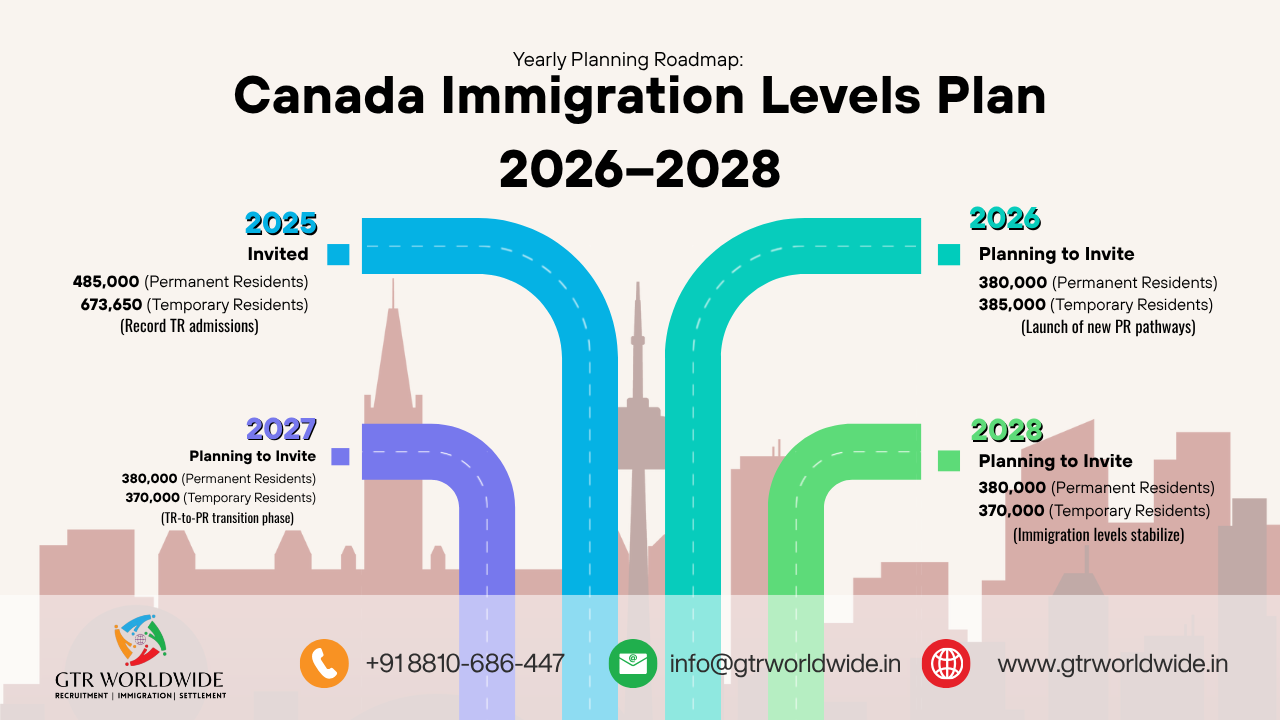Canada Announces New Immigration Levels Plan 2026–2028

Canada’s federal government has officially revealed the 2026–2028 Immigration Levels Plan, confirming a consistent intake of 380,000 new permanent residents (PRs) annually for the next three years.
This plan highlights a shift toward stability and sustainability, while at the same time opening new pathways for temporary residents — including foreign workers, international graduates, and protected persons — to transition to permanent residency (PR) in Canada.
According to Immigration, Refugees and Citizenship Canada (IRCC), the plan is designed to balance economic growth with population management and address national challenges such as housing shortages, infrastructure pressure, and service demand.
A Balanced Immigration Approach for Long-Term Growth
The 2026–2028 plan focuses on selecting immigrants already living and working in Canada, ensuring a smoother integration into the economy and communities.
Canada aims to maintain strong immigration outcomes while reducing temporary resident (TR) admissions — a major policy shift from the previous years.
Canada’s Immigration Targets 2025–2028
| Year | Permanent Residents (PR) | Temporary Residents (TR) | Key Highlights |
| 2025 | 485,000 | 673,650 | Record TR admissions |
| 2026 | 380,000 | 385,000 | Launch of new PR pathways |
| 2027 | 380,000 | 370,000 | TR-to-PR transition phase |
| 2028 | 380,000 | 370,000 | Immigration levels stabilize |
This adjustment aims to bring the temporary resident population down to below 5% of Canada’s total population by the end of 2027.
New Measures: Pathways from Temporary to Permanent Residence
One of the key features of the new plan is the launch of special PR transition programs for temporary residents. The government will introduce a one-time or limited-duration initiative to grant permanent residency to up to 33,000 work permit holders between 2026 and 2027.
Additionally, IRCC announced a two-year measure to recognize and grant PR to eligible Protected Persons currently residing in Canada.
These changes reflect the government’s focus on an “in-Canada selection model”, where preference is given to candidates who already contribute to the economy, speak English or French, and have local experience.
Overview of New PR Transition Programs (2026–2028)
| Category | Duration | Expected Beneficiaries | Description |
| Work Permit Holders | 2026–2027 | Up to 33,000 | Temporary foreign workers with Canadian experience may qualify for PR through a one-time pathway |
| Protected Persons | 2026–2028 | Thousands | Humanitarian initiative granting PR to eligible residents already in Canada |
| International Graduates | Ongoing | Continuous | Expanded PR options through Express Entry and PNP systems |
Economic Immigration Remains Canada’s Priority
Under the 2026–2028 Immigration Levels Plan, economic immigration will account for up to 64% of total admissions — an increase from the previous 59%.
Programs like Express Entry and Provincial Nominee Programs (PNPs) will continue to be the main channels for skilled workers to settle in Canada permanently.
Provinces and territories will also gain greater flexibility to align their immigration nominations with regional labour market needs, especially in healthcare, construction, and technology sectors.
What to Expect in 2026 and Beyond
- Mid-2026: Expected launch of TR-to-PR transition stream.
- Ongoing: Focus on permanent over temporary pathways.
- 2027–2028: Gradual stabilization of immigration growth.
- After 2028: More emphasis on integration, housing, and community development.
Conclusion
The 2026–2028 Immigration Levels Plan reflects Canada’s continued commitment to inclusive, sustainable immigration.
By maintaining steady PR targets while introducing new Temporary to Permanent Residence (TR to PR) pathways, the government is ensuring that people already contributing to the country’s success can make Canada their permanent home.
For foreign workers, graduates, and temporary residents, 2026 marks the beginning of a new era of opportunity.

